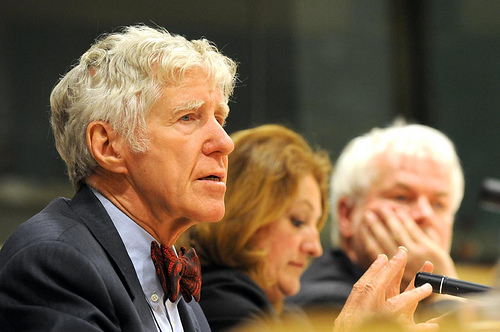 Don’t stop making sense: Lester Brown testifies tirelessly, but is anyone listening?I don’t agree with everything Lester Brown says, but the man generally talks good sense. Which means he’s absolutely marginalized in today’s key policy debates. If people in Congress would quit protecting client industries and squriming over polls and just listen to straight-talking Cassandras like Brown, we might stand a chance of averting climate/food disaster.
Don’t stop making sense: Lester Brown testifies tirelessly, but is anyone listening?I don’t agree with everything Lester Brown says, but the man generally talks good sense. Which means he’s absolutely marginalized in today’s key policy debates. If people in Congress would quit protecting client industries and squriming over polls and just listen to straight-talking Cassandras like Brown, we might stand a chance of averting climate/food disaster.
Of course, they might listen to Brown if their constituents demanded it. But I fear that Brown’s policy-wonk prose and penchant for charts–both of which I admire–don’t get him much traction with The Public.
Well, Brown’s got another iteration of his “Plan B” series out, called Plan B 4.0: Mobilizing to Save Civilization. The hyperbolic subtitle won’t likely move many units–not many people stop to listen to the guy with the “end is nigh” sandwich board. But I do hold out hopes that at least some Congressional staffers and mid-level agency functionaries might read Brown. Maybe some of his insights–and urgency–will percolate upwards.
In his latest version of Plan B, Brown focuses on food security, which he calls civilization’s “weak link” as we move into an era of climate change. From a “fact sheet” (PDF) released along with the book:
• The tripling of grain prices from 2006‐2008 was trend‐driven (unlike event‐driven surges in the past). Among the trends are the annual addition of 80 million people, 3 billion people moving up the food chain, and one fourth of the U.S. grain harvest being used to produce fuel for cars. On the supply side are falling water tables, eroding soils, and rising temperatures, all making humanity more vulnerable to food shortages.
• Some 175 million Indians and 130 million Chinese are fed with grain irrigated by overpumping wells. Saudi Arabia, Iran, and Yemen face similar challenges due to groundwater depletion.
• After decades of nutritional gains, the number of hungry people has jumped from 825 million in the mid‐1990s to over 1 billion in 2009. Combined with rising food prices and intensifying competition for land and water, this trend has opened a disturbing new chapter in the politics of food scarcity.
Intense stuff. Brown gave a telephone press conference Tuesday to outline the findings in his new book. David Roberts will not be pleased with the message Brown delivered on the climate bill that’s about to be debated in the Senate: Brown repeatedly argued that a carbon tax, and not cap-and-trade, should be the basis of climate policy.
In a Q&A after his presentation, I asked Brown what he thought about farm-policy reform. Much to my delight, he went on an extended jag about the utter absurdity of the U.S. goverment’s $5 billion/year ethanol program–how silly it is, given the serious nature of climate change, to counter it with the frivolous policy of turning grain into liquid fuel for internal-combustion engines. While he went on, I tried to interrupt to ask what he thought of cellulosic ethanol. He didn’t seem to hear me, but i can see why he didn’t even consider cellulosic in his response. First of all, it doesn’t exist at commercial scale, and remains, as it has for decades, at least five years away.
Moreover, if it’s dumb to think you’re going to power a 211-million-strong fleet of internal-combustion engines, designed for energy-rich petroleum, by turning corn sugar into alcohol, than it’s downright insane to think you’re going to achieve that by turning stuff like corn cobs and grass into ethanol fuel. How many corn cobs will it take to offset significant amounts of petroleum, which represents the compressed energy of millions of years of rotting biomass?
Clearly, it makes much more sense to change the nature of car engines. And that’s what Brown calls for. Like lots of smart people, he’s pushing for a switch to electric cars, combined with a greening of the power grid. (He also advocates real investments in trans-city speed trains and inner-city light rail.) In terms of farm policy, Brown’s vision means “phasing out the ethanol subsidies” (yes!) and putting in place incentives for midwestern farmers to install wind turbines on their land. Brown envisions a new kind of midwestern farm with grass-fed cattle wandering amid wind turbines.
That would mean less land devoted to corn but also less demand for corn–by slashing ethanol production and switching from corn-fed to grass-fed beef, U.S. corn consumption would decline dramatically.
Imagine the environmental knock-on effects. Less corn planted would mean dramatically less nitrogen and phosphorous runoff into streams–meaning healthier waterways clear down to the the nutrient-choked Gulf of Mexico. And less synthetic nitrogen fertilizer to turn into nitrous oxide–a greenhouse gas with something like 300 times more heat-trapping energy than carbon.
In short, Brown’s work makes bracing reading for any serious policy maker. Perhaps Obama will read it on the plane on his way to Copenhagen to shill for Chicago’s Olympic bid? Sure is pretty to think so.


